- Submissions

Full Text
Trends in Textile Engineering & Fashion Technology
Effect of Blend Ratio on Quality Characteristics of Polyester/Cotton Blended Ring Spun Yarn
Manik P*, Majumder S and Hossain RK
Department of Textile Engineering, Bangladesh
*Corresponding author: Manik P, Department of Textile Engineering, Bangladesh
Submission: February 18, 2019;Published: April 01, 2019

ISSN 2578-0271 Volume5 Issue1
Abstract
Cotton is a cool, soft, comfortable and is the principal clothing fiber of the world. Cloths made of this fiber absorb and release perspiration quickly, thus allowing the cloth to “breath.” The advantages of polyester over cotton fibers are its strength, brightness, easy-care, low price, consistency in quality and availability. But it has low moisture regain (0.4%) as compared to cotton (8%). There is no perfect fiber that contains all the qualities of cotton and polyester mentioned above. In this context, blending is the technique to combine fibers which emphasizes the good qualities and minimizes poor qualities of the fibers. In blends of polyester/cotton, the fibers provide crease recovery, dimensional stability, tensile strength, abrasion resistance, moisture absorption, drape ability, etc. Different blend ratios of P/C have been considered for experiment, i.e., 100% cotton, CVC (60% cotton, 40% polyester) and PC (50% cotton and 50% polyester). In this work, we studied the yarn characteristics with several P/C blend ratios of 30/s Ne. Here, the properties of blended ring spun yarns are compared with the same of 100% cotton yarn and the results are discussed in terms of the following quality parameters: Mass irregularity (CV% and U%), Thick, Thin & Naps (IPI: Imperfection Index), CSP, single yarn strength and Hairiness.
Keywords:Polyester-cotton blend; Blending ratio; Yarn properties; Performance of blended yarn
Introduction
Blending of various fibers is extensively practiced for uplifting the performance and the aesthetic properties of cloth. Blended of natural fibers with man-made ones can provide the benefits of combining the good properties of both fiber components, such as comfort, softness, strength etc. These advantages also allow an increased variety of products to be made and deliver a stronger marketing advantage [1]. Reckoning of the performance of blended yarns has also been studied by numerous authors [2-5]. Natural fibers and their blends with man-made fibers improve the performance characteristics. They may be used for clothing, underwear, socks, hygienic, textile products as well as for composites [6]. Blending in the cotton spinning process has the aim to make yarn with suitable quality and cost. Use of adequate machines and techniques to select bales and knowledge of its characteristics is necessary to produce a good quality blend [7]. Years back, it had been a common practice to carry out the blending of natural and synthetic fiber in sliver form on the draw frame. The best blend in longitudinal direction was obtained in this way [8]. Department of Textile Engineering, Bangladesh. Li & Yen [9] investigated that, fiber properties have a significant effect on yarn strength. However, Nawaz [10] concluded that the gradual decrease in yarn strength occurs as the share of polyester fibers in the blend decreases. Anandjiwal & Goswami [11] suggested that blending dissimilar fibers lead to their non-uniform distribution throughout the yarn cross section, which in turn, lead to preferential migration depending on both fiber properties and mechanism of spinning process adopted. Therefore, the present study was carried out to figure out the effect of polyester/cotton blend ratio on quality characteristics of resultant yarn.
Methodology
The study was conducted in a well-known spinning mill situated at Gazipur, Dhaka, Bangladesh to see the quality of polyester-cotton blended yarn with respect to blending ratio. In Table 1 & 2 the details of the machineries and equipment’s, used in this study, is given. For the purpose of experiencing the quality of polyester-cotton blended yarn the following cotton and polyester samples are consider, which are shown in Table 3-5 in details. After having the cotton and polyester with mentioned mixing ratio, the resultant yarn was observed for testing the performance depending on the blending ratio. Uster® evenness tester 4 was used to have the quality parameters and performance of the polyester-cotton blended yarn. Here, three types of blend ratio were considered for yarn count of 30s’, i.e., KW (100% Cotton), CVC (60% cotton + 40% polyester) and PC (50% cotton + 50% polyester). The comparison of quality parameters of these three blends was subjected in this study, which is given in Table 6 & 7.
Table 1:Detailed overview of the production machineries use is given.
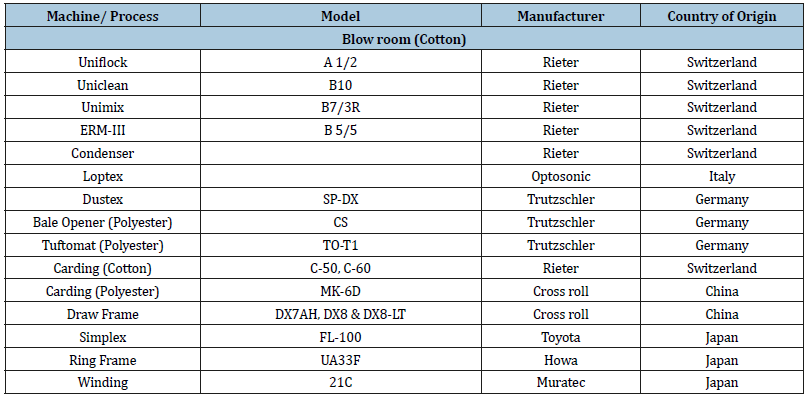
Table 2:Detailed overview of the testing equipment’s used is given.

Table 3:Mixing ratio of cotton fiber is given.
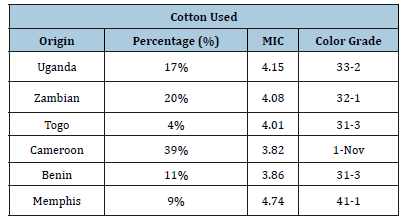
Table 4:Lab testing summary of cotton fiber is given.

SCI: Spinning Consistency Index, Mic: Micron Aire Value, M: Maturity Ratio, U%: Uniformity Ratio, SFI: Short Fiber Index, +b: Degree of Yellowness, +Rd: Degree of Reflexes, CG: Color Grade of Cotton, UHML: Upper Half Mean Length
Table 5:Ratio of polyester fiber is given.

Table 6:Uster test result is given.

KW: Carded Yarn for Weaving, CVC: Cheap Value Cotton, PC: Polyester-Cotton Blend, CSP: Count-Strength Product, CV%: Coefficient of Variance, DR: Drawing Ratio, H: Hairiness Value, IPI: Imperfection Index
Table 7:Results of single yarn strength tester is given.

B. Force: Breaking Force, R. Work: Work of Rupture
Results and Discussions
Effect of polyester/cotton blend ratio on u% & cv%
Figure 1:Effect of polyester/cotton blend ratio on u% & cv%.

Figure 1 shows the relationship between the yarn blend ratio and U% & CV% for various blend ratios of cotton and polyester. It is clearly revealed in the graph that U% & CV% decrease gradually with the increase in polyester proportion. We hereby infer that increase in polyester share in blend results in lower U% and CV% and that the increase proportion of polyester brings down yarn U% and CV% to an appreciable extent.
Effect of polyester/cotton blend ratio on thick +50%/ km
A relationship between the blend ratio and number of thin places in the yarn for the various blend ratios was found. It is observed that the number of thin places in the yarn decreases with the increase in the polyester proportion in the blend, which is shown in Figure 2
Figure 2:Effect of polyester/cotton blend ratio on thick +50%/km.

Effect of polyester/cotton blend ratio on thin -50%/km
Figure 3:Effect of polyester/cotton blend ratio on thin-50%/km.

From Figure 3, it is observed that there is a relation between the blend ratio and number of thin places in the yarn for the various blend ratios. It is also observed that the number of thin places in the yarn decreases with the increase in the polyester proportion in the blend.
Effect of polyester/cotton blend ratio on NEPS 200%/ km
Figure 4:Effect of polyester/cotton blend ratio on NEPS 200%/Km.

The study revealed a relationship between the blend ratio and the NEPS 200% in the yarn per km. There is an inverse nature of NEPS (200%/km) with the increase in polyester proportion in the blend, which is shown in Figure 4.
Effect of polyester/cotton blend ratio on IPI [thick (+50%)+thin (-50%)+NEPS (+200%)]
Figure 5:Effect of polyester/cotton blend ratio on IPI [thick (+50%)+thin (-50%)+NEPS (+200%)].

Figure 5 shows the relation between the blend ratio and the IPI in the yarn. IPI graph also shows an inverse nature with the increase in polyester share in the blend. So, an increase in polyester share in the blend has much lower IPI (Imperfections).
Effect of polyester/cotton blend ratio on CSP
Figure 6:Effect of polyester/cotton blend ratio on CSP.
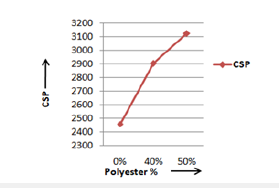
Figure 6 explains the strength values of the various blend ratio yarns. The graph reveals that increase in polyester proportion increases the yarn strength, which infers that an increase in polyester share in the blend has much higher CSP.
Effect of polyester/cotton blend ratio on hairiness
Figure 7:Effect of polyester/cotton blend ratio on hairiness.
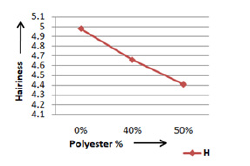
A relation between blend ratio and hairiness index of the various blended yarns is stated in Figure 7. The nature of the graph shows that, an increase in polyester share in the blend decreases the hairiness of the yarn.
Effect of polyester/cotton blend ratio on strength
Figure 8:Effect of polyester/cotton blend ratio on strength.

Figure 8 determines the tenacity values of the blended yarns. The graph shows that the tenacity value increases with the increase in polyester proportion. We hereby infer that increase in polyester share in the blend has much higher strength.
Effect of polyester/cotton blend ratio on elongation at break
Figure 9:Effect of polyester/cotton blend ratio on elongation at break.
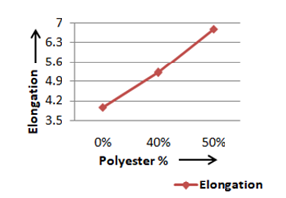
The elongation of the yarn for the various blend proportions is stated in Figure 9. The graph reveals that, there is an increase in extension with an increase in the polyester share in blend.
Effect of polyester/cotton blend ratio on work of rupture
Figure 10:Effect of polyester/cotton blend ratio on work of rupture.

Figure 10 reveals the work of rupture values of the blended yarns, showing that the work of rupture value increases with the increase in polyester share in the blend.
Conclusion
The study was carried out to figure out the effect of polyester/ cotton blend ratio on quality characteristics of resultant yarn. The study reveals that, with the increase in polyester share in the blend, the overall quality parameters of yarns are improved. Some of them are U%/CV%, IPI, Hairiness, CSP and single yarn strength. At the same time, moisture regain% of the yarns decreases with the increase in polyester share in the blend; Such as, for 100% cotton: MR is 8.4%, for 40/60 PC: MR is 5.7% and for 50/50 PC: MR is 5.0%. However, depending on the end uses, the optimum percentage of polyester and cotton may be adjusted.
Acknowledgment
The authors are grateful to Yasmin Spinning Mills Ltd., Gazipur, Bangladesh for the support to the data collection required for this study.
References
- Svetnickienė V, Čiukas R (2009) Investigation of friction properties of yarns from natural fibers. Mechanics 75(1): 73-76.
- Pan N, Postle R (1995) Strengths of twisted blend fibrous structures: theoretical prediction of the hybrid effects. The Journal of the Textile Institute 86(4): 559-580.
- Pan N, Chen K, Monego CJ, Backer S (2000) Studying the mechanical properties of blended fibrous structures using a simple model. Textile Research Journal 70(6): 502-507.
- Kemp A, Owen JD (1995) The strength and behavior of nylon/cotton blended yarns undergoing strain. Journal of the Textile Institute 46(11): T684-T698.
- Jianchun Z, Peixing F (1999) Predicting the tensile strength of lyocell/ PET blended yarns. ITB International Textile Bulletin 6(99): 28-30.
- Ratnam TV, Narayana SK, Underwood C, Govindarajulu K (1968) Prediction of the quality of blended yarns from that of the individual components. Textile Research Journal 38(4): 360-365.
- Béchir A, Hassen MB, Sakli F (2008) Adjustment of cotton fiber length by the statistical normal distribution: application to binary blends. Journal of Engineered Fibers and Fabrics 3(3): 35-46.
- Klein W (1987) The technology of short staple spinning. The Textile Institute, Manchester, England, pp. 21-24.
- Li Y, Yan H (1990) Measuring unevenness and blend ratio of yarns with microwave resonators. Textile Research Journal 60(1): 54-59.
- Nawaz SM, Shahbaz B, Yousaf CK (1999) Effect of different blends with various twist factors on the quality of p/c blended yarn. Pakistan Textile Journal 48(6): 26-29.
- Anandjiwal R, Goswami BC, Charles KB, Bargeron JD (1999) Structural property relationship of blending cotton yarns made from low and high tenacity fibers. Textile Research Journal 69(2): 129-138.
© 2019 Manik P . This is an open access article distributed under the terms of the Creative Commons Attribution License , which permits unrestricted use, distribution, and build upon your work non-commercially.
 a Creative Commons Attribution 4.0 International License. Based on a work at www.crimsonpublishers.com.
Best viewed in
a Creative Commons Attribution 4.0 International License. Based on a work at www.crimsonpublishers.com.
Best viewed in 







.jpg)






























 Editorial Board Registrations
Editorial Board Registrations Submit your Article
Submit your Article Refer a Friend
Refer a Friend Advertise With Us
Advertise With Us
.jpg)






.jpg)














.bmp)
.jpg)
.png)
.jpg)










.jpg)






.png)

.png)



.png)






